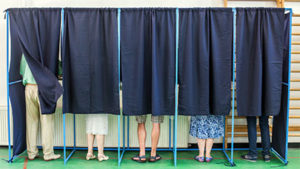
Polling Data Hidden in Plain Sight

(Alexandru Nika/Shutterstock)
The gnashing of teeth you may be hearing is the sound of political pollsters whose elegant models completely missed the surge of popular discontent in the hinterlands that propelled Donald J. Trump to the U.S. presidency.
One could ask whether overreliance on big data or its political ground-game equivalent—some call it “little data“—failed utterly as a replacement for knocking on doors, asking the right questions and generally beating the bushes to figure out the mood of the country. Or as the veteran political journalist Elizabeth Drew tweeted on election night: “Did no one poll the farmers?”
A very good question.
Along with an overreliance on big data and faulty databases, the post-election post-mortems revealed fundamental errors in data gathering. For example, it has come to light that pollsters were over-relying on placing calls to landlines rather than mobile phones. As one observer noted, “A poll built only on respondents who have an old-style phone is fundamentally flawed in our world.”
One gumshoe that did talk to voters was CNN reporter Jake Tapper, who noted amidst the frenzied election night coverage that he had stopped by an old haunt in South Philadelphia to ask the proprietor, For whom his customers were casting their president ballots? Tapper reported that the business owner’s reply was that there were a surprising number of “leaners” among his customers, as in, they leaned in close and confided, “I’m voting for Trump.”
No fancy polling model could capture that kind of voter sentiment, and nearly all the high-paid pollsters who blew the election predictions failed in this fundamental task.
Among the few analytics tools that appeared to have predicted what was really going on in this divided country was a visualization tool developed by San Francisco-based MapD Technologies Inc. The platform is designed to track campaign contributions using U.S. Federal Election Commission data.
MapD’s analysis of campaign donations contained a nugget of ground truth that we were not smart enough to recognize when we reported it in the days before the election. Despite Trump’s fundraising shortfall, the MapD tracker found that the president-elect had succeeded in tapping into smaller, mostly rural donors across the country making individual campaign contributions under $200.
These were the very same voters—some lifelong Democrats—who came out in droves in previously Blue (Democratic) states to push Trump’s Electoral College tally well above the 270 votes needed to win the election.
As we wrote in the days before the election without realizing the significance, the MapD visualization of 2016 campaign donations revealed that Trump had expanded the map of political donors while “tapping into a constituency that had not given in previous cycles.”
The result, for better or worse, is President-Elect Donald J. Trump.
Recent items:
Data Visualizations Follow the Campaign Money
Trump Victory: How Did the National Polls Get It So Wrong?



























